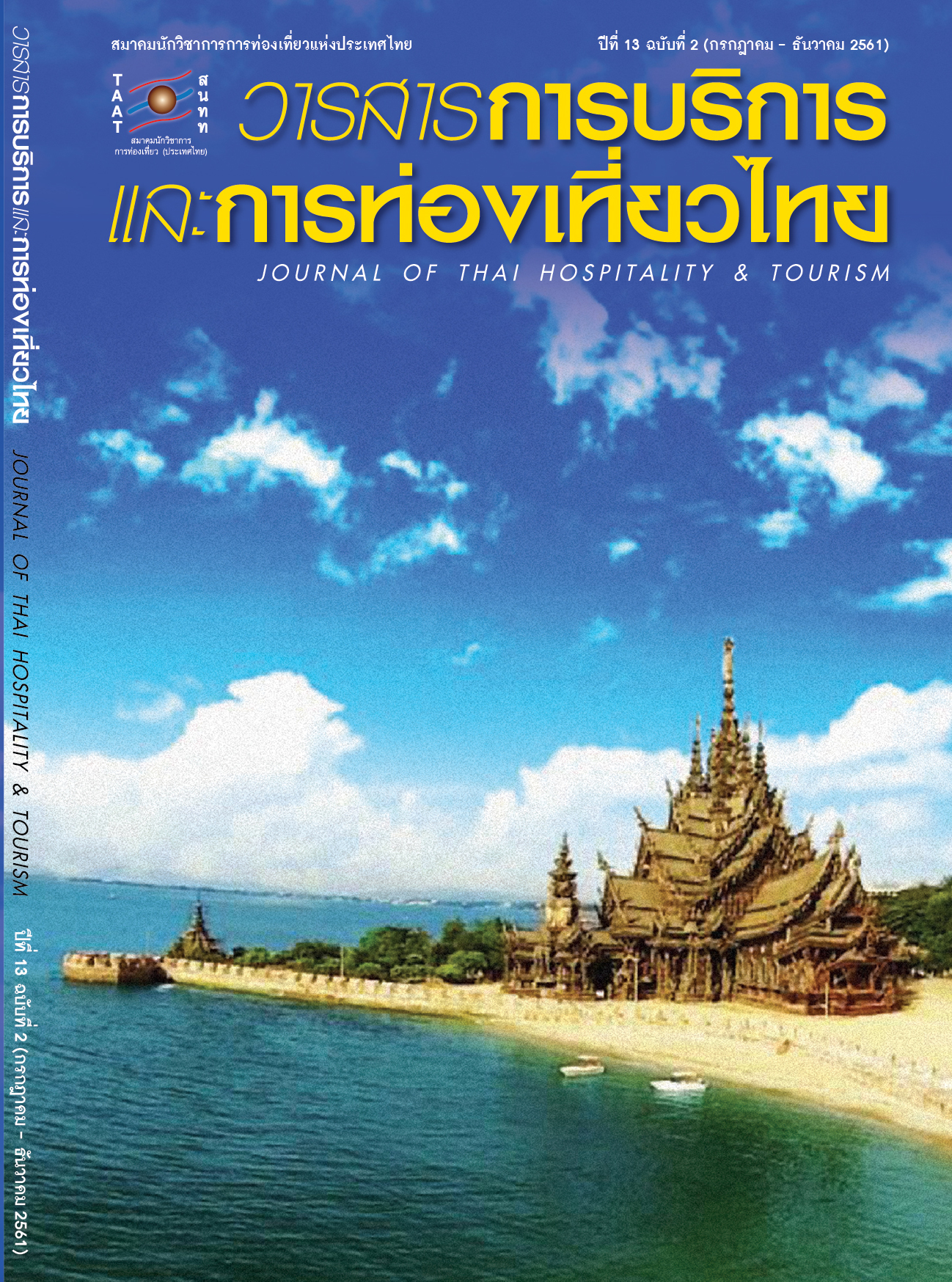The Early Adult Chinese’ s Attitude towards Tourism Image of Thailand Singapore and Malaysia
Main Article Content
Abstract
การวิจัยครั้งนี้เป็นงานวิจัยเชิงปริมาณ (Quantitative Research) มีวัตถุประสงค์เพื่อศึกษาภาพลักษณ์ทางการท่องเที่ยวของประเทศไทย สิงคโปร์ และมาเลเซียในทัศนะของชาวจีนวัยผู้ใหญ่ตอนต้น กลุ่มตัวอย่างเป็นประชาชนชาวจีนที่มีช่วงอายุ 18 – 35 ปี และต้องพำนักอาศัยอยู่ในพื้นที่เทศบาลนครทั้ง 4 ของจีน ได้แก่ ปักกิ่ง ฉงชิ่ง ซ่างไห่ และเทียนจิน จำนวน 400 คน โดยใช้แบบสอบถามและแบบสัมภาษณ์เป็นเครื่องมือในการเก็บรวบรวมข้อมูล นำผลที่ได้มาวิเคราะห์ทางสถิติ โดยหาค่าเฉลี่ย () ส่วนเบี่ยงเบนมาตรฐาน (S.D.) การวิเคราะห์เนื้อหา (Content Analysis) ผลการวิจัยพบว่า
- ภาพลักษณ์ทางการท่องเที่ยวโดยรวมของประเทศที่มีความโดดเด่นทางด้านการท่องเที่ยวของอาเซียนตามทัศนะของผู้ตอบแบบสอบถามอยู่ในระดับดี (
= 3.93) เมื่อพิจารณารายประเทศพบว่า ทุกประเทศมีภาพลักษณ์ทางการท่องเที่ยวตามทัศนะผู้ตอบแบบสอบถามอยู่ในระดับดี โดยประเทศไทยมีภาพลักษณ์ทางการท่องเที่ยวดีที่สุด (
= 3.98) รองลงมาคือ ประเทศมาเลเซีย (
= 3.95) และสิงคโปร์ (
= 3.86) ตามลำดับ
- เมื่อเปรียบเทียบภาพลักษณ์ทางการท่องเที่ยวของประเทศไทยเทียบกับประเทศคู่แข่งในอาเซียนพบว่า ภาพลักษณ์ทางการท่องเที่ยวในภาพรวมของประเทศไทยมีค่าเฉลี่ยสูงสุด รองลงมาคือ ประเทศมาเลเซียและประเทศสิงคโปร์ ตามลำดับ และเมื่อพิจารณารายด้านพบว่า ภาพลักษณ์ทางการท่องเที่ยวของทั้ง 3 ประเทศมีค่าเฉลี่ยค่อนข้างใกล้เคียงกัน โดยภาพลักษณ์ทางการท่องเที่ยวของประเทศไทยที่โดดเด่นเทียบกับประเทศคู่แข่งในอาเซียน ได้แก่ ด้านทรัพยากรทางธรรมชาติ (
= 4.32) ด้านบรรยากาศของสถานที่ (
= 4.24) และด้านศิลปวัฒนธรรม/ประวัติศาสตร์ (
= 4.07) ส่วนภาพลักษณ์ทางการท่องเที่ยวของประเทศไทยที่เป็นจุดอ่อนเทียบกับประเทศคู่แข่งในอาเซียน ได้แก่ ด้านเศรษฐกิจและการเมือง (
= 3.55)
Article Details
How to Cite
Kieanwatana, K. (2018). The Early Adult Chinese’ s Attitude towards Tourism Image of Thailand Singapore and Malaysia. Journal of Thai Hospitality and Tourism, 13(2), 16–24. retrieved from https://so04.tci-thaijo.org/index.php/tourismtaat/article/view/151038
Section
Research Article
References
[1] Bangsantiea, Prakaidao. (2015). Marketing Scan “Chinese Millionaires”: Thailand Tourism from “Mass” to “Quality”. Retrieved May 8, 2016 from https:/www.bangkokbiznews.com/news/detail/645283.
[2] Beerli, A. & Martin, J. D. (2004). Factors Influencing Destination Image. Annuals of Tourism Research, 31(3), 657-681.
[3] Buakong, Avikarn. (2014). Government Urged to Recover Thailand's Tourism Image. Retrieved June 24, 2016, from https://www.dailynews.co.th/economic/276077.
[4] Echtner, C. M., & Ritchie, J. R. B. (1993). The Measurement of Destination Image: An Empirical Assessment. Journal of Travel Research, 31(4), 3-13.
[5] Esichaikul, Ranee. (2010). Tourism Promotion for Senior Tourists from Europe to Thailand. Journal of Thai Hospitality and Tourism, 5(1), 50-66.
[6] Jaworski, S. P. (2003). National Brand Identity & Its Effect on Corporate Brands: The Nation Brand Effect (NBE). Retrieved April 1, 2016, from https://findarticles.com.
[7] Klapper, J. T. (1960). The Effects of Communication. New York: Free Press.
[8] Nunnally, J. C. & Bernstein, I. H. (1994). Psychometric Theory. 3rd ed. New York: McGraw-Hill.
[9] Nuttavuthisit, Krittinee. (2007). Branding Thailand: Correcting the Negative Image of Sex Tourism. Place Branding and Public Diplomacy, 3(1), 21-30.
[10] Vanichbuncha, Kanlaya. (2006). Statistics for Research. 2nd ed. Bangkok: Chula Press.
[11] Rovinelli, R. J. & Hambleton, R. K. (1977). On the Use of Content Specialists in the Assessment of Criterion-Referenced Test Item Validity. Dutch Journal of Educational Research, 2(1), 49-60.
[12] Srisutthipan, Sandee. (n.d.). Thailand Tourism Business: Chinese Tourist Market in Thailand. Retrieved September 28, 2015, from https://www.thaibizchina.com/.
[2] Beerli, A. & Martin, J. D. (2004). Factors Influencing Destination Image. Annuals of Tourism Research, 31(3), 657-681.
[3] Buakong, Avikarn. (2014). Government Urged to Recover Thailand's Tourism Image. Retrieved June 24, 2016, from https://www.dailynews.co.th/economic/276077.
[4] Echtner, C. M., & Ritchie, J. R. B. (1993). The Measurement of Destination Image: An Empirical Assessment. Journal of Travel Research, 31(4), 3-13.
[5] Esichaikul, Ranee. (2010). Tourism Promotion for Senior Tourists from Europe to Thailand. Journal of Thai Hospitality and Tourism, 5(1), 50-66.
[6] Jaworski, S. P. (2003). National Brand Identity & Its Effect on Corporate Brands: The Nation Brand Effect (NBE). Retrieved April 1, 2016, from https://findarticles.com.
[7] Klapper, J. T. (1960). The Effects of Communication. New York: Free Press.
[8] Nunnally, J. C. & Bernstein, I. H. (1994). Psychometric Theory. 3rd ed. New York: McGraw-Hill.
[9] Nuttavuthisit, Krittinee. (2007). Branding Thailand: Correcting the Negative Image of Sex Tourism. Place Branding and Public Diplomacy, 3(1), 21-30.
[10] Vanichbuncha, Kanlaya. (2006). Statistics for Research. 2nd ed. Bangkok: Chula Press.
[11] Rovinelli, R. J. & Hambleton, R. K. (1977). On the Use of Content Specialists in the Assessment of Criterion-Referenced Test Item Validity. Dutch Journal of Educational Research, 2(1), 49-60.
[12] Srisutthipan, Sandee. (n.d.). Thailand Tourism Business: Chinese Tourist Market in Thailand. Retrieved September 28, 2015, from https://www.thaibizchina.com/.


